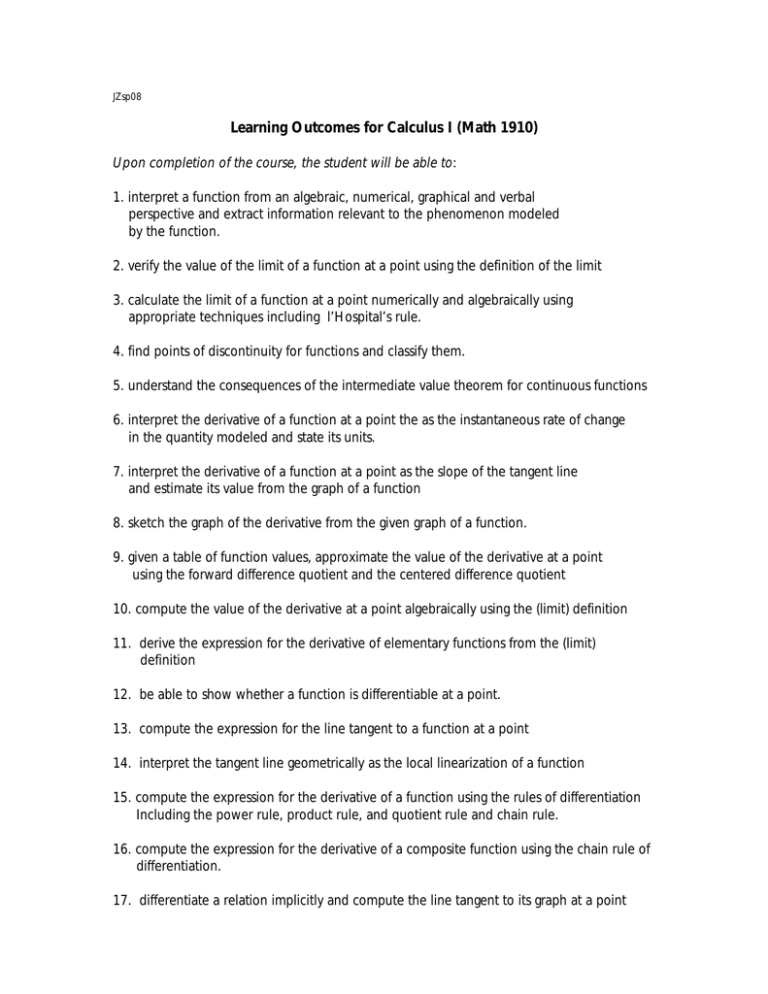Learning Outcomes for Calculus I (Math 1910)
advertisement

JZsp08 Learning Outcomes for Calculus I (Math 1910) Upon completion of the course, the student will be able to: 1. interpret a function from an algebraic, numerical, graphical and verbal perspective and extract information relevant to the phenomenon modeled by the function. 2. verify the value of the limit of a function at a point using the definition of the limit 3. calculate the limit of a function at a point numerically and algebraically using appropriate techniques including l’ Hospital’ s rule. 4. find points of discontinuity for functions and classify them. 5. understand the consequences of the intermediate value theorem for continuous functions 6. interpret the derivative of a function at a point the as the instantaneous rate of change in the quantity modeled and state its units. 7. interpret the derivative of a function at a point as the slope of the tangent line and estimate its value from the graph of a function 8. sketch the graph of the derivative from the given graph of a function. 9. given a table of function values, approximate the value of the derivative at a point using the forward difference quotient and the centered difference quotient 10. compute the value of the derivative at a point algebraically using the (limit) definition 11. derive the expression for the derivative of elementary functions from the (limit) definition 12. be able to show whether a function is differentiable at a point. 13. compute the expression for the line tangent to a function at a point 14. interpret the tangent line geometrically as the local linearization of a function 15. compute the expression for the derivative of a function using the rules of differentiation Including the power rule, product rule, and quotient rule and chain rule. 16. compute the expression for the derivative of a composite function using the chain rule of differentiation. 17. differentiate a relation implicitly and compute the line tangent to its graph at a point 18. differentiate exponential, logarithmic, and trigonometric and inverse trigonometric functions. 19. obtain expressions for higher order derivatives of a function using the rules of differentiation 20. interpret the value of the first and second derivative as measures of increase and concavity of a functions. 21. compute the critical points of a function on an interval. 22. identify the extrema of a function on an interval and classify them as minima , maxima or saddles using the first derivative test. 23. use the differential to determine the error of approximations. 24. understand the consequences of Rolle’ s theorem and the Mean Value theorem for differentiable functions 25. find the anti-derivative of elementary polynomials, exponential, logarithmic and trigonometric functions. 26. interpret the definite integral geometrically as the area under a curve 27. construct a definite integral as the limit of a Riemann sum 28. approximate a definite integral using left sum, right sum, midpoint and trapezoidal rules 29. interpret the indefinite integral as a definite integral with variable limit(s). 30. interpret differentiation and anti-differentiation as inverse operations (Fundamental Theorem of Calculus, part 1) 31. interpret the anti-derivative as a definite integral with variable limit and implement this expression on graphing platforms 32. evaluate a definite integral using an anti-derivative (Fundamental Theorem of Calculus, part 2) 33. use substitution to find the anti-derivative of a composite function. 34. apply basic optimization techniques to selected problems arising in various fields such as physical modeling , economics and population dynamics.